You’ve heard of Mendoza and Malbec, but have you heard of Cafayate and Torrontes?
This is Argentina’s unsung hero of wine regions. It is, in reality, where Argentina’s wine industry was born. The Spanish first planted vines here in 1556. The high altitude lends itself to incredible wine.
But beyond the wine, the natural landscapes here are staggeringly beautiful. Cafayate is a blend of Mendoza and America’s Southwest.
Rugged red canyons, waterfalls, vineyards, goat cheese and more – you won’t regret a visit to Salta.
This post is a complete guide on the best things to do in Cafayate, where to stay, what to pack, and more.
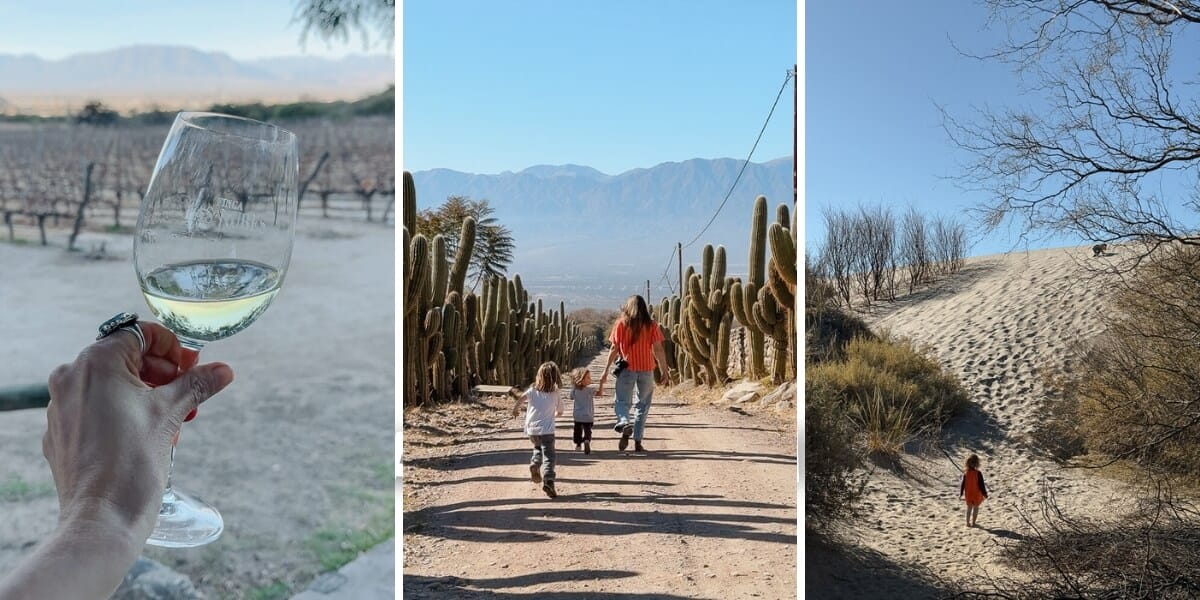
QUICK NOTE: This post contains affiliate links and Sol Salute may receive a commission for purchases made through these links, at no extra cost to you.
QUICK NOTE: This post contains affiliate links and Sol Salute may receive a commission for purchases made through these links, at no extra cost to you.
Things to do in Cafayate, Argentina
Salta is Argentina’s second most important wine region and Cafayate is the heart of it all. Wineries here are close to town (some right IN town), they’re affordable, and easy to visit.
Beyond the vineyards, there are beautiful hikes to waterfalls and otherworldly landscapes in the Quebrada de las Conchas – or Shell’s Gorge.
I’ve been lucky enough to visit Cafayate three times now and will never tire of its wineries and epic scenery.
If you’re wondering what to do in Cafayate besides the wineries, this post is a complete guide to the region including hikes, drives, and empanadas.
What more could you want?
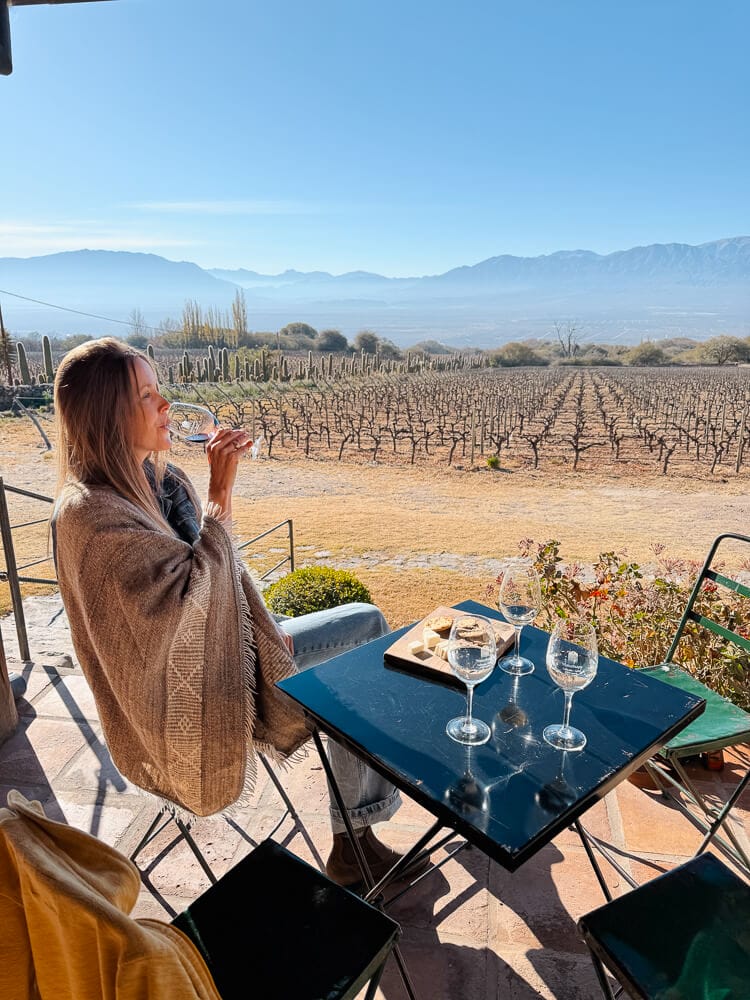
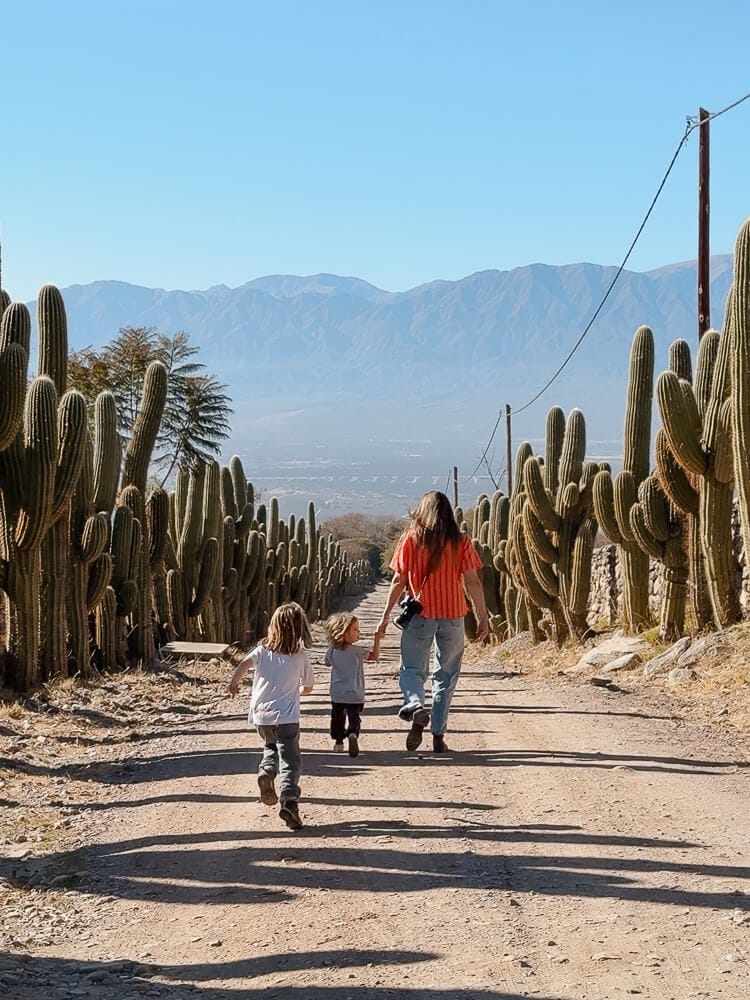
Enjoy the Wineries
The wineries in Cafayate are the biggest attraction here.
This is Argentina’s second-largest wine region, specializing in Torrontes, the only truly local varietal native to Argentina. It is crisp and aromatic.
Torrontes is called the “lying grape” because it smells sweet on the nose but on the tongue it is crisp and fresh. If you want to also taste a sweet wine, try the candy-sweet Torrontes Cosecha Tardia (literally Late Harvest) that makes a great dessert wine.
Wine tasting in Cafayate is accessible in both affordability and location. Wineries are located either directly in town or nearby on the outskirts.
My favorite wineries in town are Porvenir and Nanni. Outside of town I love Fincas Las Nubes and Yacochuya, both offer incredible views. For a full and detailed guide, read my post about the best wineries in Cafayate.
If you don’t have a rental car, you can rent bikes to tour the bodegas. Your hotel or hostel may have bikes free to use but if not, Majo Viajes on the main square has rental bikes available for just a few dollars an hour.
💡Interesting Fact: The legacy of Argentina’s wine industry can be traced back not to Mendoza, but right here in Salta. Spain’s final royal governor in the province brought Malbec and Cabernet Sauvignon vines from France and planted them in Molinos, on today’s Ruta 40. The rest is proverbial history and we all owe him our thanks.

the Quebrada de Las Conchas
The Quebrada de las Conchas is one of Salta’s most beautiful natural wonders (among many, honestly).
This gorge’s rugged red canyons and geological formations rival what you’ll see in America’s Southwest. And the best part is that you can view it all with a fraction of the crowds if you time it just right.
This scenic drive lasts 50 kilometers just outside of Cafayate on Ruta 68 in the direction of Salta city. You can drive, bike, hike, and even horseback ride through these epic formations.
Most fly through the quebrada on their way in or out of Cafayate, making quick stops at the main formations.
But you could easily spend hours, the whole day, or dare I say days even, in the Quebrada de las Conchas. It all depends on what you want to do and how you want to do it.
For example, one day with the kids we spent the entire day in just a few spots – the morning in the sand dunes, a long lunch with llamas and empanadas, a couple hours climbing and playing at Los Colorados and along the river. If you like to go slow, you can find plenty of ways to entertain yourself here.
But if you are on a short itinerary, you can see the main formations in just a couple of hours.
How to see the Quebrada de las Conchas:
- First, read my Complete Guide to La Quebrada de las Conchas with all the main formations, pit stops, and more.
- Guided tour from Salta city – Short on time? Take this day trip from Salta to Cafayate. It hits up all the highlights of the quebrada and includes a wine tasting in Cafayate. It’s quick but it’s better than nothing.
- See it on your way in or out of Cafayate – The Quebrada de las Conchas is on Ruta 68 on the drive from Salta to Cafayate. It’s very easy to stop at the formations along your route to or from the airport or the city.
- Hike the Quebrada de las Conchas – For a short walk, spend an hour hiking in La Yesera. For a longer trek, consider hiking a guide to go deep into the gorge and up close to the formations.
- Bike the Quebrada de las Conchas – Your hostel or hotel may have bikes for you to borrow, if not, Majo Viajes rents bikes for just a few dollars an hour on the main square. Taxis here have bike racks or the Flecha bus company can store the bike in the luggage hold for you. Have the bus driver or our taxi drop you off at the Garganta del Diablo. From here, bike back to Cafayate, stopping along the way to enjoy the formations and viewpoints.
- Horseback rides – Some tour operators offer horseback rides into the quebrada, some even at night to appreciate the clear night sky and to see the stars. Majo Viajes was mentioned to me by my hotel, for example.
Want to stay IN the Quebrada de las Conchas? On our second Cafayate trip, we stayed at Castillos de Cafayate, located in the quebrada itself with panoramic views of Los Castillos. It’s just a 15 minute drive from downtown and it was worth every penny and every second in the car.

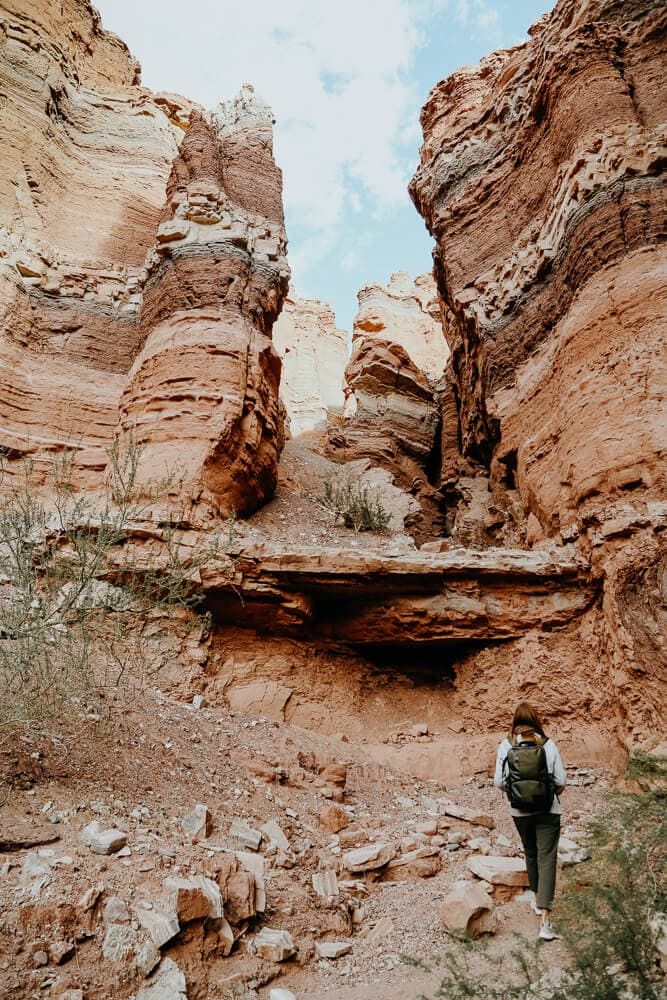
La Yesera: Hike to Los Estratos
Within La Quebrada de las Conchas at Kilometer 28 on Ruta 68 you’ll see the trailhead for Los Estratos with a small gravel parking lot.
This is a short, easy hike.
It took us 30 minutes to get there and another 30 back. Note that we move slowly to take photos and generally gape open-jawed at the landscapes.
This is a must-do experience when in the Quebrada de las Conchas if you can manage the time.
You’ll get deeper into the Quebrada and leave the tour buses. It is very high reward for low effort.
Empanadas and Llamas: If you’re hungry after Los Estratos, head to the white house just before the trailhead, it’s in Google Maps as “La Tienda de la Yesera”. This small shop sells clay pottery, snacks, delicious empanadas, and best of all, there are llamas. Feed them a handful of corn kernels while you wait for your empanadas to fry up.
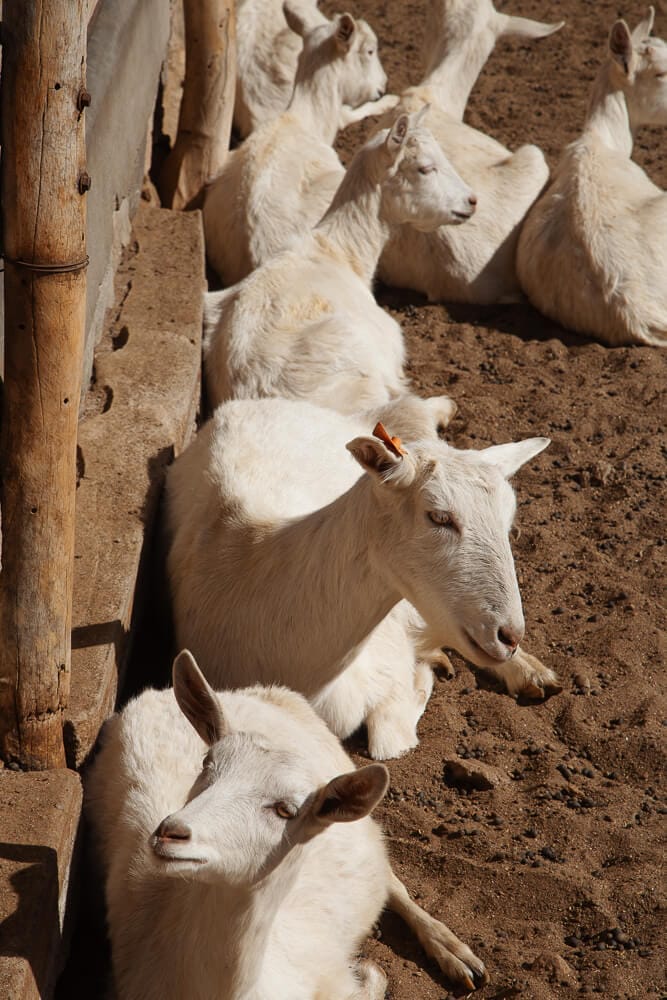
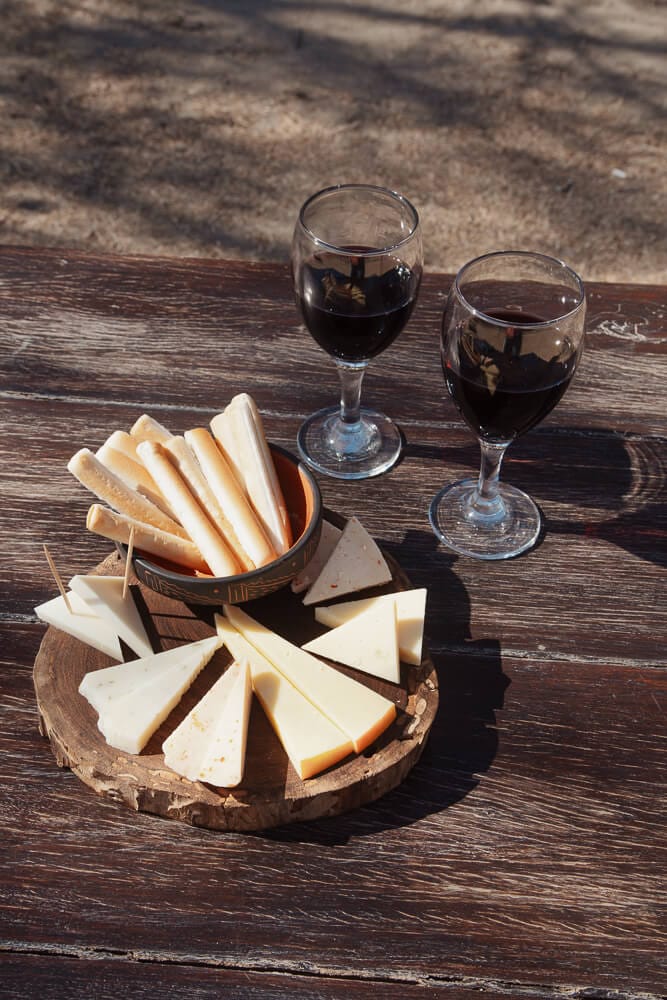
Cabras de Cafayate
As you drive through Salta you’ll see fields of corn and alfalfa. But most of all, you’ll see goats.
Goats can not only survive but they can thrive in this harsh landscape. They can sustain communities and small families in isolated locations.
And for us, the result of all these goats is some pretty damn good goat cheese.
Cabras de Cafayate is a local goat farm open for tourim just outside of downtown Cafayate.
It’s owned by the same family that owns the Domingos Hermanos winery and each of these two ventures helps sustain the other.
Goats provide fertilizer for the vineyard and the leftover crushed grapes feed the goats. Everything is sustainable and geared towards the goat’s wellbeing.
CABRAS LOGISTICS: Tours take place throughout the day and you don’t need to reserve in advance. During our recent visit they were at 10/11/12/15:30/16:30 Monday-Saturday, and at 10/10:45/11:30 on Sundays. The cost was around $10 US for the tour, it included a cheese tasting platter and a glass of wine. Message them on Instagram to confirm current hours and costs.
Family Friendly – Beyond the obvious fact that kids love to watch baby goats, they have a great playground on site where the kids can play while you enjoy your tasting after the tour.
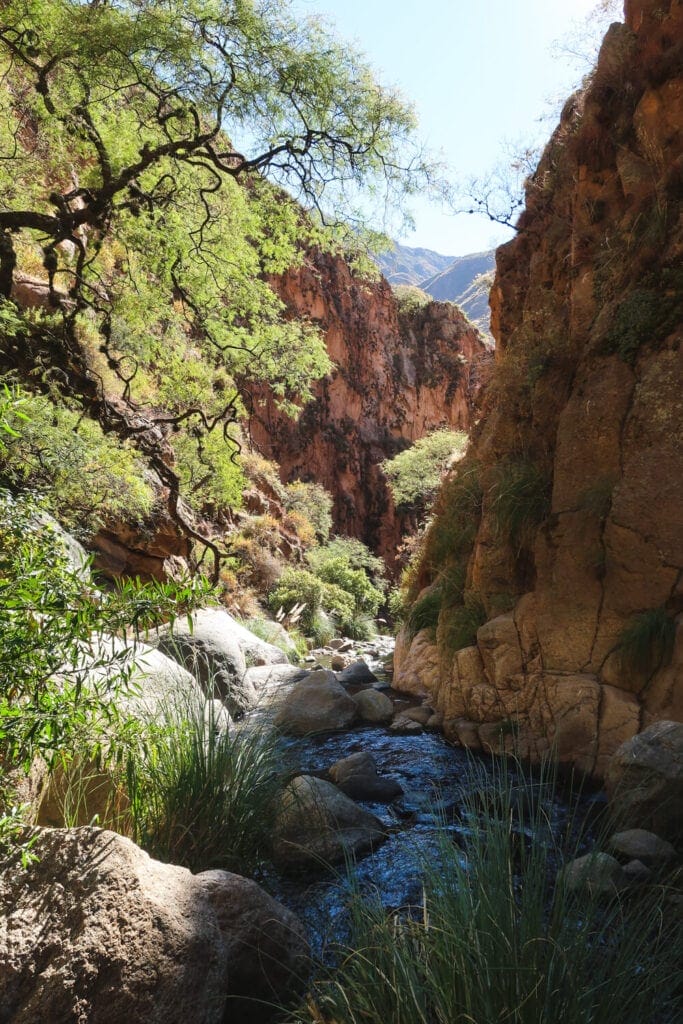
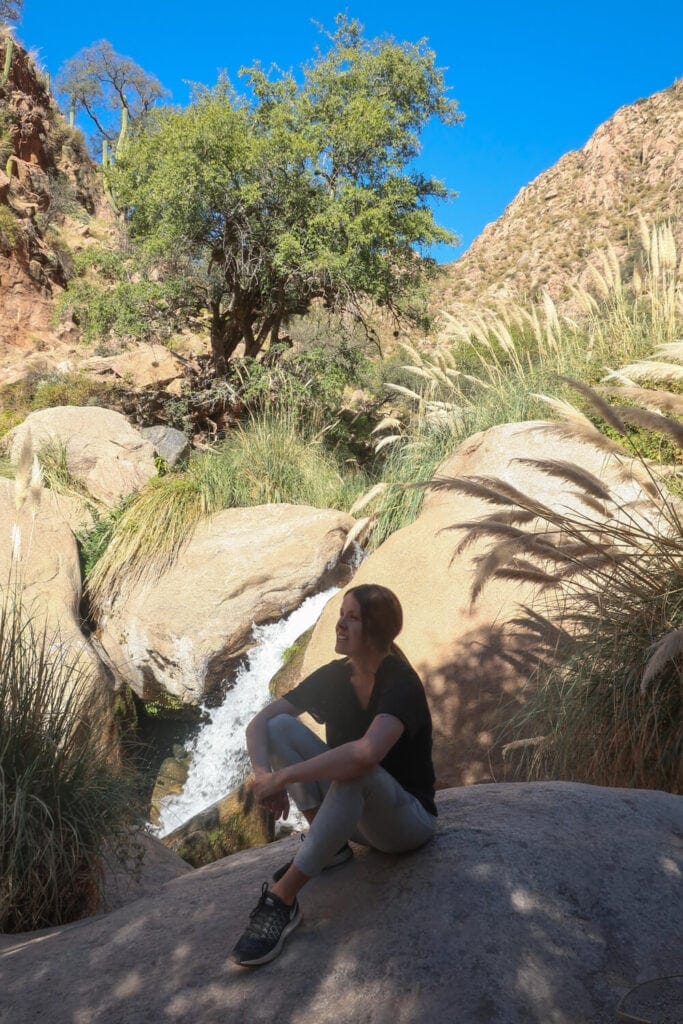
Hike Las Cascadas del Rio Colorado
The most popular trek in Cafayate is Las Cascadas. It’s a difficult trek to a series of waterfalls and it’s recommended to go with a guide.
When you arrive at the trail entrance, just past Finca las Nubes, you’ll likely see a group of guides waiting.
They’ll tell you the price and it’s standard for all of them, you can check with your hotel beforehand to have an idea of what it should be.
The cost depends on how many waterfalls you hike to and there are a total of 7.
For a less challenging hike, you can go to the first two and turn back.
I could not have done this hike (all 7 waterfalls) without a guide. Our guide was a member of the local Diaguita community and gave a lot of insight to their culture, history, and the trail.
Most of the waterfalls are rather small, two were large and impressive (like the one above). But if I’m honest, the highlight wasn’t the waterfalls or the destination, but the overall scenery along the way.
It was gorgeous hiking through the valley, surrounded by cacti, listening to the water flow below us. I know some will bristle at the group of guides that push themselves on you at the trailhead, but there really were some parts of the hike that were very dangerous, skirting along rocky cliffs etc. I would not recommend going alone, even if it were allowed.
I recommend starting this hike early in the morning. If you plan on completing the entire circuit calculate 3-4 hours. It took us three hours.
When you’re done, just drive around the corner to Finca las Nubes.
I laid on the grass with my wine, nursing my ego and bruised bum from an embarrassing fall into the river along the way.
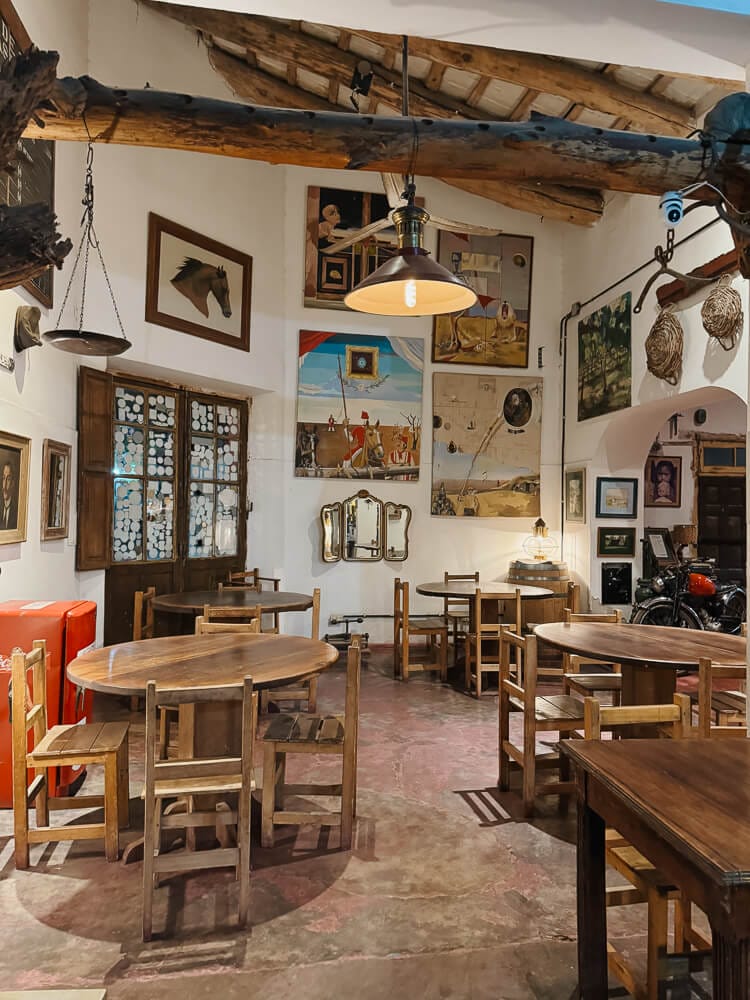

Eat All of the Empanadas, Locro, and Tamales
Argentina’s Northwest has the most traditional food in Argentina. It is my favorite cuisine here.
Hands down.
The best empanadas in Argentina are from the northwest and each province has its own style.
Empanadas Salteñas feature diced beef with potatoes, cumin, and paprika. They’ll serve them with a fresh spicy tomato sauce called Salsa Yasgua. Spoon it generously onto each bite.
Try hearty stews like locro with beans, corn, red chorizo, and meat.
In Buenos Aires, it’s reserved for patriotic holidays but you can and should eat it regularly here in the north. It will warm your bones on cold Cafayate nights.
Tamales and humita (similar to a tamal but filled with cheesy cream corn filling) are also typical dishes that can’t be missed.


Try The Alfajores at Calchaquitos
Alfajores are a traditional Argentina sweet.
The formula is simple: two cookies, something sweet in the middle (usually dulce de leche), then bathe all of that in chocolate.
Each region of Argentina has its own regional flavors that shine in alfajor form.
Here in Salta that means – miel de caña (like a whipped molasses), cayote fruit, and wine. I particularly like Calchaquitos because the cookies are extra light and crumbly. Regardless of the filling, it doesn’t feel too rich or heavy.
I also love the vintage signage and decor. I hope they never change a thing, down to the orange paint and fantastic Alfajor sign that towers over the road outside.
I recommend going on your first day and getting enough to snack on throughout your trip! Then going back at the end to stock up and fill your suitcase for gifts.


Taste the Wine Ice Cream at Heladería Miranda
While we’re discussing sweets, don’t leave Cafayate without trying wine ice cream.
You’ll see it at a lot of the restaurants on the main square but the original (and the best) is from Heladería Miranda on Av. General Guemes.
I’ve tried it at a couple of places and Miranda’s truly is the best.
They have Torrontes and Cabernet Sauvignon. Get a cone with a scoop of each. Follow their advice and start with the Torrontes, just like a proper wine tasting.
Read More: All About Ice Cream in Argentina (& The Best Heladerías in Buenos Aires)

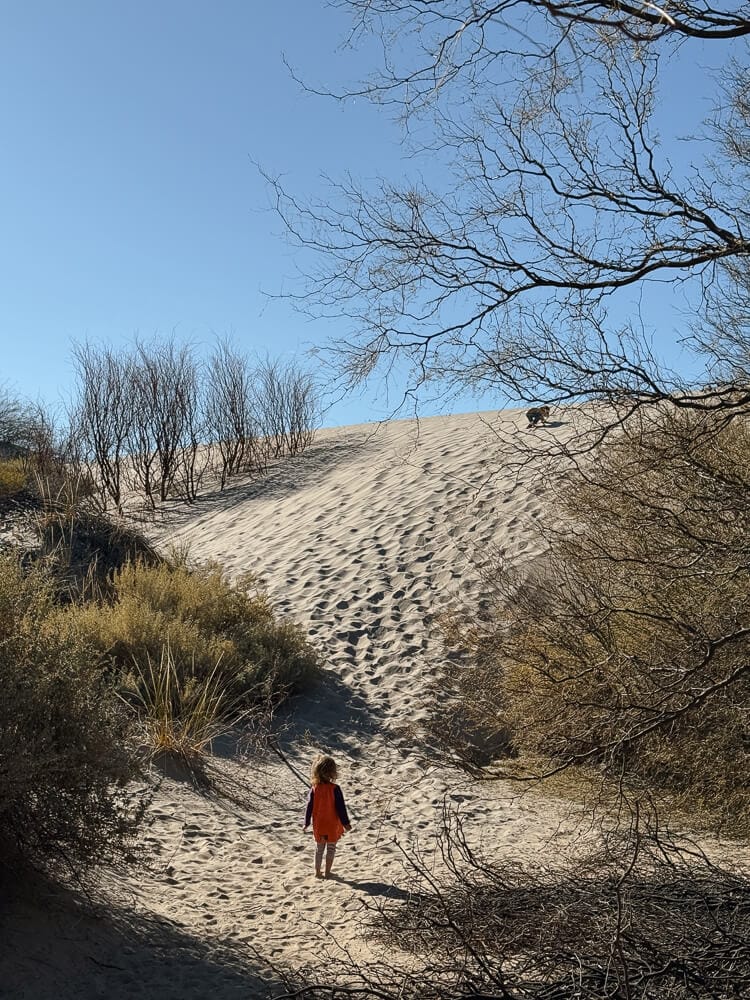
Los Medanos: Climb the Sand Dunes
At kilometer 6 on Ruta 68 just north of town just off the road, but hidden by scraggly brush, are massive sand dunes.
You’ll see the kilometer markers on the side of the road, at KM 6 look for a small parking lot. There is a Difunta Correa shrine here as well, so look for that sign to know you’re in the right place.
A path opens up parallel to the highway. You can drive it 200 meters to another lot or just leave your car here and walk. In 5-10 minutes you’ll be at the sand dunes, walking parallel to Ruta 68 the entire time.
It’s shocking – to me, at least – how close they are to the highway but you really don’t see them until you’re right up on them. Literally on them, scramble up the sand and play.
And if you are traveling Argentina with kids, welcome to paradise. This is one massive sandbox, my toddlers were in heaven rolling down the hill, scrambling back up, and even making “sand angels.”
We went mid-morning and saw a lot of Argentines here with their mate and a breakfast.
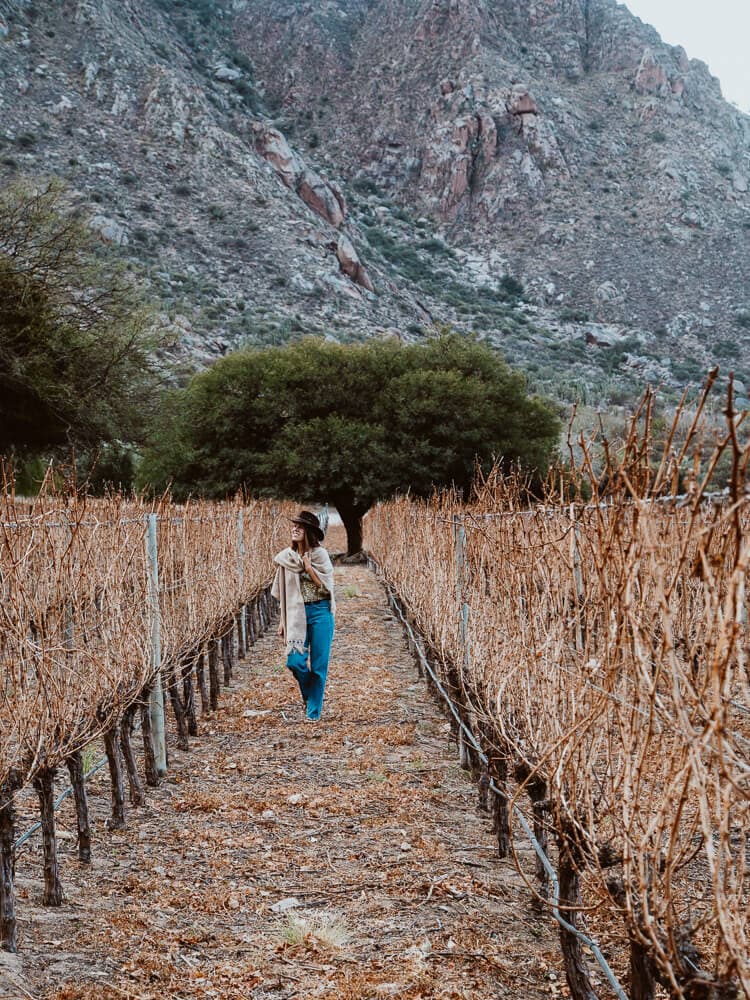

Museo de la Vid y el Vino
Cafayate’s wine museum is Cafayate’s most popular museum.
It relies heavily on technology and interactive exhibits going into the history of winemaking here.
Personally, I didn’t enjoy it. It’s a great museum, I’m just not here to be cooped up in a museum. I’m here to be sipping wine in the mountains.
If you’re visiting any of the wineries you’ll likely learn most of this on a tour in a much more beautiful setting.
But it is very informative. If you want to learn about the region in more detail then I recommend it.
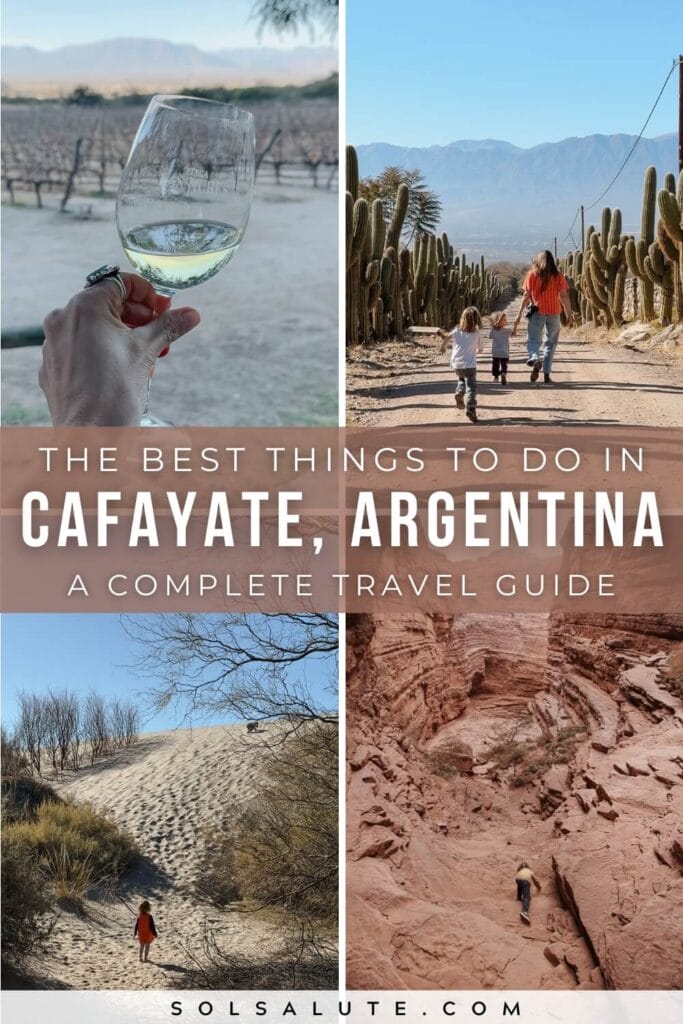
Rodolfo Bravo Archaeological Museum
This small museum at Colón 191 is filled from floor to ceiling with pre-Colombian artifacts.
There’s a third room with more recent historical items from the time after colonization.
It’s cluttered and packed to the brim with the findings of Don Rodolfo, a local resident of Cafayate. His widow currently manages the museum and is very knowledgeable and passionate about her collection.
If you manage to meet her you’ll be in for the most unexepedtly enthralling museum experience of your life.

Catedral Nuestra Señora del Rosario
Argentina’s Northwest is the most devout region of Argentina. And thanks to the Spanish colonization of this region, it is absolutely littered with stunning, centuries old churches.
Cafayate’s church on the main plaza was built in 1885 to replace the Cathedral that was falling into ruin but Cafayate’s first church dates back to 1740.
There are five naves and this cathedral is one of only three remaining structures in South America.
Shop at the Artisan Markets
Salta is souvenir heaven. I recommend traveling with some extra space in your bag, you’ll need it.
Woven tapestries, clay pottery, ponchos, sweaters, silver jewelry… I wanted everything.
There are a few artisan markets on the main square as well as a cooperative shop. All offer items directly from the artisan.
Across the street from the Wine Museum is an interesting building with a giant llama on the facade. Inside it’s filled with pottery from floor to ceiling.
🍷Wine Carry On: And speaking of souvenirs, did you know you can carry on up to 6 bottles of wine on domestic flights within Argentina? So go ahead and buy some bottles to bring back with you! Put a bottle or two in your luggage or ask a winery for a case that you can fill and tape up to use as your personal carry on (it must go below the seat in front of you).
Where to Eat in Cafayate
Wineries are the best and most obvious choice on where to eat in Cafayate.
In particular, I love the lunch menu at Finca Los Nubes. It’s casual with outdoor seating on their lawn overlooking their vineyard and the town below.
Piattelli is another excellent winery for lunch or dinner. We booked their sunset tour that included a bottle of wine and a picada at their restaurant after the tour. It was one of the best experiences of our trip, watching the sunset behind the quebrada.
Lunch or dinner at La Rosa at Bodega El Esteco is another Cafayate classic. We had lunch but the ambiance at dinner looks very romantic.
For a more casual winery lunch in town, try Nanni’s restaurant, El Retoño.
My favorite restaurant in town is Baco. It’s not on a winery but it’s where the winemakers go. We had incredible rabbit and duck empanadas and locro. For a nicer dinner in town, don’t miss Bad Brothers.
And for the best empanadas, go to the appropriate named La Casa de las Empanadas just a block off of the main plaza. It’s cheap, it’s delicious, it’s a hole in the wall. I love it.
Where to Stay in Cafayate
I’ve been to Cafayate a few times now and always find myself returning to the same hotel – Villa Vicuña. It is my preferred hotel due to a number of reasons, namely because it toes the perfect balance between an accessible price point with impeccable style and comfort.
But over the years I’ve also experienced a luxurious resort and tried another hotel in the quebrada. Let’s break down the best Cafayate accommodation options…

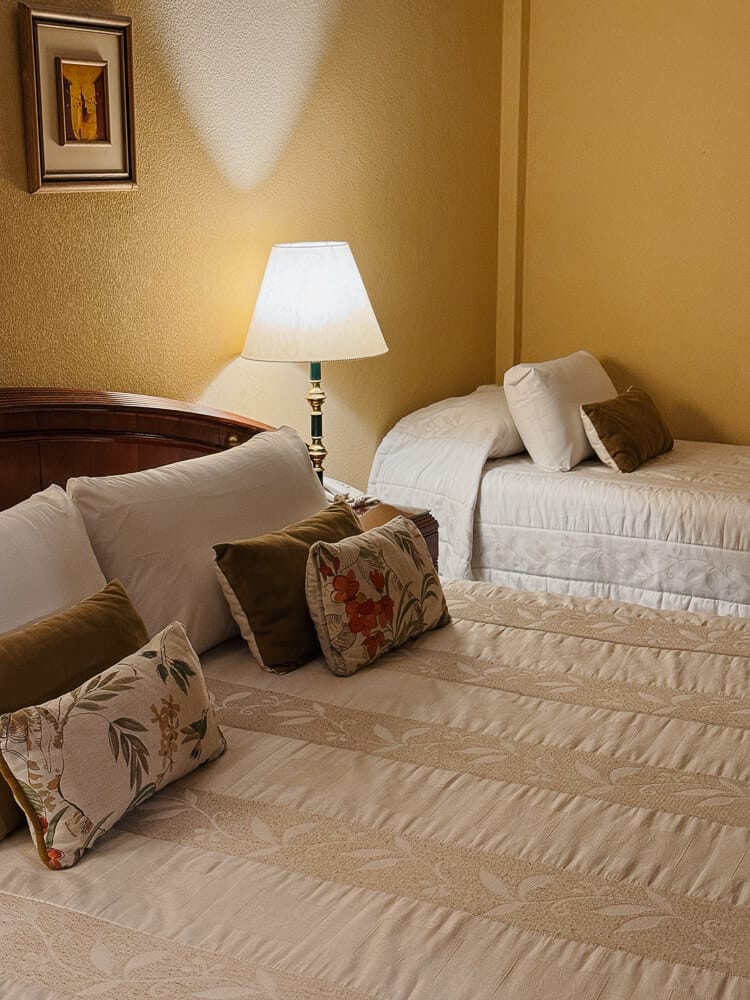
Villa Vicuña – The Best Boutique Hotel
Location, location, location. Villa Vicuña Cafayate has the best location, just half a block off of the main square. You are steps from the best restaurants, shops, and just about everything you need. It is even just around the corner from two wineries, El Transito and Bodega Nanni.
I’ve stayed in Villa Vicuña twice and I’ll stay here again in the future.
Villa Vicuña also has a property in the city of Salta, check it out here. You are guaranteed a cohesive experience by staying at their properties in both cities.
Villa Vicuña Cafayate is housed in a beautifully restored colonial building. There are only 12 rooms that all have direct access to the courtyard. There are tables and lounge areas (indoors and out) to relax with a glass of wine or coffee at the end of the day before dinner.
Breakfast is included and served buffet style with a variety of options ranging from eggs and toast to yogurt, granola, fresh fruit salads and local options like medialunas.
Book your stay at Villa Vicuña
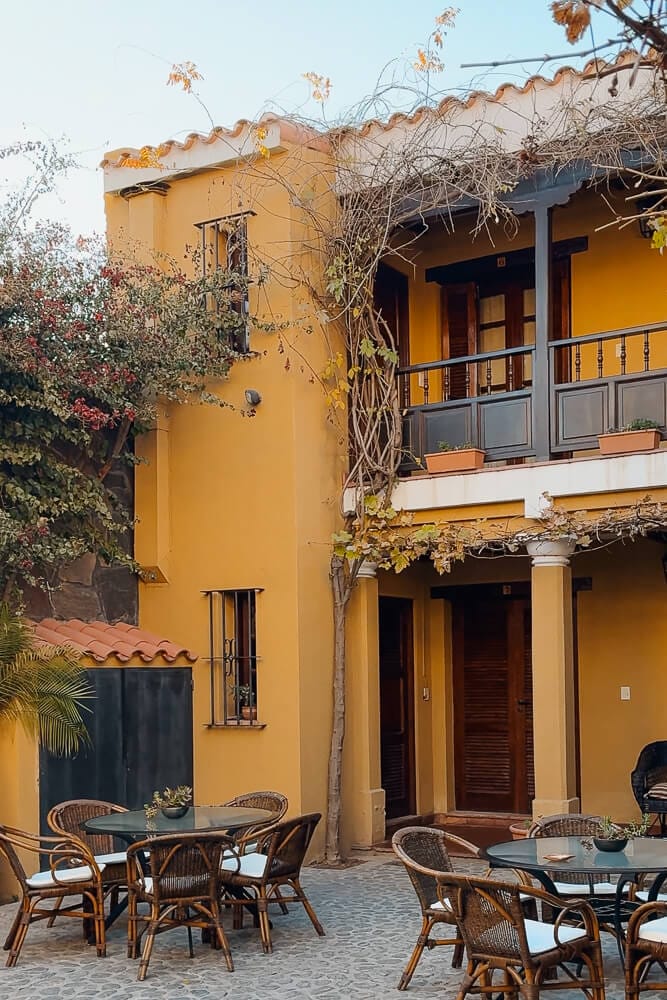

Grace Cayate – Luxury Hotel & Spa
Grace Cafayate is a luxury property just outside of the city. The estate is also a residential neighborhood with an 18 hole golf course. If you’re wanting to treat yourself in a place that you could honestly never leave, stay at Grace.
Of course, you can still leave to tour the wineries and sites, it is only a 10 minute drive. Other guests did leave. But… if you wanted to relax at their pool all day, I would not blame you.
We were invited to try out their new family program, so yes, this hotel is ideal for couples and families alike. The villas are huge with a lot of room to spread out. Each has its own hot tub, grill, and private areas like a lawn and living room (that was more comfortable than my own at home).
For our stay, we participated in workshops like finger painting in the vineyard and ceramics. My oldest made his own snack plate out of traditional clay ceramics. This trip really raised the bar on what he will be expecting on future holidays.
Grace offers other activities such as horseback riding, cooking classes to learn how to make the region’s famous empanadas, and of course, the spa.
Book your stay at Grace Cafayate
More Cafayate Hotels for all budgets
- PATIOS DE CAFAYATE | My parents stayed here as they were looking for a more colonial resort feel. They loved it. While it’s not far from town, you’d think you were miles away while on the grounds. We came for lunch and fell in love with the property.
- CASTILLOS DE CAFAYATE | This was my hotel choice for our second trip. The location is unbeatable with panoramic views of the Quebrada from every room. Prices are very affordable and rooms were large and great for families (in fact, most guests were local families like us). The downside is that it’s very far from town, 30 minutes to be exact. You do need a car because taxis here add up and are a hassle this far out. It’s definitely an amazing property but stick to town if you don’t have transportation or want to be closer to the wineries. Check prices here.
- CAFAYATE HOSTELS | If you’re on a backpacker’s budget, Cielito Lindo is a beautiful option with cheap dorm rooms and affordable private rooms.
What to pack for Cafayate
Salta is a casual destination. Think sneakers, not heels. Prioritize comfort. You’ll want grippy sneakers or boots to walk in the dirt and rocks of the vineyards and quebrada.
While you can dress up for the wineries, it’s far from expected. You’ll even see plenty of tourists touring in their hiking clothes or athleisurewear.
Here’s a few guidelines and tips on what to bring:
- Comfortable clothing: Jeans or better, hiking pants like these that can be dressed up or down. Pack lightweight shorts for the summer.
- Winter – Light Layers – Temperatures fluctuate in the desert. Bring a jacket or coat, scarf, and fleece for the evening but be prepared to be down to a t-shirt by noon while in the sun, even in the winter.
- Summer – Dress for the heat. Pack shorts, ideally some with movement like these hiking shorts. Protect yourself from the sun and the heat. Hike in a long sleeve, light weight shirt like this sun shirt, a sunhat, and always sunglasses. For non-athleisurewear go for long sleeve linen shirts.
- Sun protection: At this altitude the sun is very strong, wear sunscreen every day, sunglasses to protect your eyes, and if you’re extra sensitive like me, also pack chapstick with SPF.
- Water bottle: Avoid issues from the altitude (and wine) by staying hydrated.
- Travel adaptor
- Wine Suitcase – If you plan on picking up a lot of bottles, invest in a wine suitcase. This may sound extreme and only for the truly obsessed but my friend always travels with hers to bring a case back home with her safely..

When to visit Cafayate
The best time to visit Argentina’s Northwest is during winter or the shoulder seasons. This region is sunny nearly every day of the year. Despite temperatures dropping at night, the days will likely be sunny and warm.
Summer is a busy travel season all over Argentina, so plan in advance if you want to go from the holidays through February. And this is the desert, so expect hot temperatures in the summer.
If you are interested in visiting during the harvest, grapes are harvested during the months of April and May in Cafayate. This is notably later than in Mendoza, which is during March.
And while winter means bare vines due to pruning, I still think it’s the best time to visit this region. We visited Tucuman (just 20 minutes south of Cafayate by car) in March during the tail end of summer and really suffered the heat.
More Salta Resources
- The Best Wineries in Cafayate
- A Detailed Travel Guide to Salta
- Things to do in Cachi, Salta
- The Best Wineries in Cachi
- The Perfect Salta Road Trip: Our Salta Itinerary
- Salta & Jujuy: A 9 Day Northwest Argentina Road Trip Itinerary
- Things to do in Jujuy, A Complete Travel Guide
Argentina Travel Resources
- BOOK A CONSULTATION | I offer one-on-one travel consultations to help you plan your trip to Argentina. Pick my brain to get a local’s insight. Click here for more information.
- MY MAP | Buy my interactive map with 300+ pins to have access to the city as I see it. It is an invaluable resource. See more here about how it works.
- AIRPORT TRANSFERS | Having a driver waiting for you is ideal for a stress free arrival, Cesar and his team here is the best option for a driver from Ezeiza or Aeroparque, they are my go-to airport ride!
- TRAVEL INSURANCE | Always travel insured. Anything can happen anywhere and it is scarier and costlier in an unfamiliar country. SafetyWing’s Essential Plan covers unexpected travel and medical emergencies and even offers add-ons like electronics theft or adventure sports. It is the best if you’re coming on vacation. If you’re coming as a digital nomad or an extended stay, you need their Complete Nomad Plan which also covers routine check ups, maternity, mental healthcare and more. Read more: Health Insurance in Argentina
- PHONE PLAN | These days, traveling with data is essential. Especially in Argentina where everything is managed on Instagram and WhatsApp. I recommend this E-SIM card. It’s hassle-free and affordable, for more read how to get an Argentina sim card.
- ACCOMMODATION IN ARGENTINA | booking.com is the most common hotel site used in Argentina and it’s where you’ll find the most options.
- RENTAL CARS | I love using Discover Cars, it is a great platform to compare different rates and providers and I find they have responsive customer service.
- BUS TICKETS | Check Busbud for long distance bus routes and tickets.
- VPN | If you’ll be using a public WiFi connection and want to secure your data, I highly recommend using a VPN, I personally use and have had a good experience with ExpressVPN. I also use it to access Hulu and American Netflix from Argentina.
- FLIGHTS | Always check Google Flights and Skyscanner for flights to and within Argentina. Aerolineas Argentina is the local airline with the most routes. FlyBondi and Jetsmart are two budget airlines with dirt-cheap prices (but expect to pay for every add-on like luggage).
PIN IT FOR LATER




We got totally stuck in Cafayate a few years ago – spending an entire week and totally skipping out on Bolivia! I don’t regret it though – it was the perfect little town to rest and relax before we continued on our journey. (And we stayed at La Morada! Glad to hear they’re still alive and kicking!)
What a beautiful place to get delayed in, I totally get how it would be hard to leave! We only had three nights and it wasn’t nearly enough! I want to go back again soon, the whole region was so beautiful, I’m glad you loved it 🙂
Love torrontes and really need to get to the source! You definitely put Cafayate on my radar.
Thanks for reading, if you love Torrontes then you have to visit Cafayate! It’s the only grape varietal native to Argentina
Thanks for reading! If you love Torrontes then you have to visit! Torrontes is actually the only grape varietal native to Argentina, since Malbec is French
I loved visiting Cafayate! It was so peaceful and the wines were of course amazing! Like you, I didn’t drink a whole lot of wine before we moved to Argentina – and then I quickly became a bottle-a-week drinker!!
Argentina will turn anyone into a wino, it’s still not turned me into a mate drinker however…
I love wine too – can’t wait to get to Argentina so I can justify drinking it all the time! The hike after looks like a great option too – to detox!
Stunning photos!
hahah you never need a reason to justify a good glass of wine!! But you’re right, the hike was a good balance